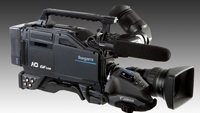Ikegami cameras capture Boston College Athletics

The new HD video control room at Boston College’s Conte Forum and Alumni Stadium produces live video content for display on the giant-screen display boards for the enjoyment of fans. Acquisition tools used to support it include an Ikegami GFCam HDS-V10 Flash RAM HD camcorder and two Ikegami HDK-77EC HD CMOS field cameras.
Mark Chambers, Boston College’s director of multimedia services for athletics, designed the new facility (working closely with Little Bay Broadcast) and its tapeless HD workflow. The new HD control room also includes two Ikegami HLM-2400s and one HLM-2450W HD LCD monitor. Chambers, whose background includes a decade with the Boston Bruins and the TD Banknorth Garden as director of game operations and entertainment, said working with digital footage instead of videotape is a major advantage and helps organize the school’s increasing archiving system.
Boston College’s two Ikegami HDK-77EC native multiformat HD CMOS field cameras will be used as the main HD game cameras. Both are outfitted with 9in Ikegami LCD color viewfinders, Canon 40x telephoto HD zoom lenses and Ikegami CCU-890M camera control units operating via SMPTE fiber connectivity. The college’s GFCam HD camcorder, meanwhile, will serve a dual purpose. It will be used as a handheld unit to shoot games (connected to the new control room with a Telecast Fiber Systems fiber-optic extension) and as a stand-alone tapeless HD camcorder for ENG-style interviews with coaches and players.
Part of Ikegami’s GFSeries tapeless Flash RAM HD/SD production solution, the HDS-V10 camcorder features three 2/3in AIT CCDs and is available in native 1080i or native 720p versions. It records HD images using MPEG-2 50Mb/s long GOP or 100Mb/s I-Frame only to GFPak Flash RAM media — available in 16GB, 32GB and 64GB capacities. A 64GB GFPak holds two hours of full-resolution (1920 x 1080 4:2.2) HD video in the 50Mb/s MPEG-2 MXF file format. GFPaks also feature a built-in USB 2.0 port, high-speed SATA interface and a remaining-capacity indicator, visible on the GFPak itself.
The professional video industry's #1 source for news, trends and product and tech information. Sign up below.
